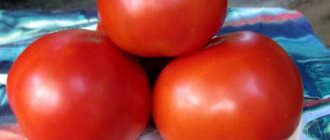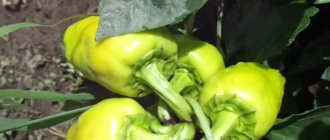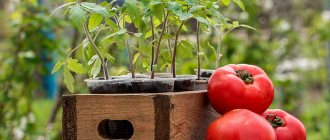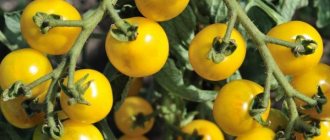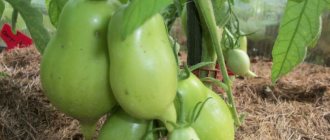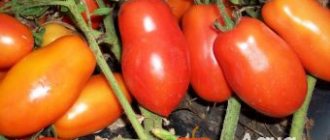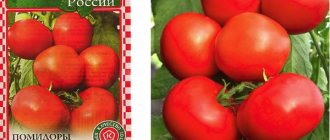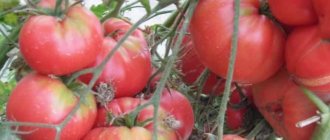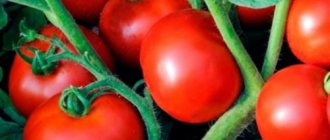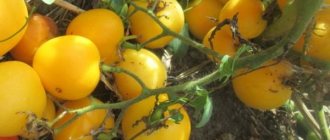| Ripening period: | early |
| Shape, weight of fruits: | cream, 50-60 g |
| Bush type: | determinant |
| Growing regions: | Central, Western Siberia, Volgo-Vyatka |
| Productivity: | 7-8 kg per m/sq. |
The early-ripening, low-growing tomato Shuttle is especially appreciated by gardeners who do not have the opportunity to provide regular care for the plot, and by beginners. It is resistant to adverse weather conditions and produces small fruits suitable for fresh salads, pickling and pickling. A good harvest can be harvested with a minimum of effort, without garters or pinching.
Description of tomato Shuttle
According to the structure of the bush, the Chelnok tomato belongs to the group of determinate plants with limited growth of the central shoot. The stem of a standard-type tomato, about 50 cm high, is strong, erect, and not subject to bending even under the weight of the fruit. This quality allows you to grow tomatoes of the Chelnok variety without tying them to a support. The leaves are not very large, but given the low growth of the plants, the bush looks curly and densely leafy. Several simple inflorescences of 5-7 flowers each are formed on the main stem. The first cluster of fruits is laid after 4-6 leaves. A few lateral shoots are formed in the axils of the leaves, the growth of which is limited to one flower raceme.
Description of fruits
The name of the variety is directly related to the shape of its fruits, which resemble the shuttle of some sewing machines or looms. They are round, oblong, narrowed at the bottom and end with a thin sharp tip. When fully ripe, the tomatoes are a uniform, rich red color, smooth, not ribbed. The skin is durable, not prone to cracking, and tolerates transportation well. The fruits of the variety are quite small, up to 70g, but the appearance of the Chelnok tomatoes is attractive and memorable.
Tomatoes taste quite sweet, the flesh has a dense consistency, the number of seed chambers is small, and the seeds are medium in size. When cut, the flesh does not crack, holds its shape, and the skin is easily cracked. The fruits of the Chelnok variety have a pleasant tomato aroma.
Transplanting to a garden bed
Before planting on the plot, the seedlings are gradually accustomed to fresh air - they are hardened off on a glazed balcony or veranda for several hours a day. A day before the transplant, she is left to spend the night on the street.
Before sampling, the plants are shed generously with water to eliminate the risk of injury to the roots during transplantation.
The transplantation procedure is carried out provided that the soil temperature has reached 12°C and the air temperature has reached 16-18°C.
Transplantation should be done in warm soil
Preparing the bed
To grow this crop, choose a sunny and windless place. The soil is prepared in the fall - per m² the following is added: a bucket of peat or compost, 1 kg of wood ash and 2 tbsp. l. superphosphate and potassium salt. Then the soil is dug up without breaking up the lumps.
Transplantation technique
In the prepared area, holes are made at the rate of 4-5 holes per m². The depth and width of the planting holes must correspond to the dimensions of the seedling container, since transplantation is carried out together with a lump of earth. The distance between the holes is 35-40 cm.
Before planting, each hole is spilled with water. Consumption per hole - 1 liter.
A wooden peg is driven in near each bush, which will later serve as a support for an adult plant.
Characteristics of tomato
The taste characteristics of the Chelnok variety are lower than those of some large-fruited tomatoes, but are not inferior to them in terms of the content of beneficial vitamins and microelements. The variety is interesting because it has a number of undoubted advantages and is suitable for cultivation in various regions. The Chelnok tomato variety receives positive reviews and looks impressive in the photo.
Productivity and fruiting
Among determinate low-growing tomatoes, Chelnok is quite a competitive variety. From 1 m², under favorable weather conditions, only about 8 kg of fruits are harvested, or 2.0-2.5 kg from one bush. Tomatoes on fruit clusters ripen gradually, so the harvest time is more extended than with other early ripening varieties. Fruiting of the Chelnok can last from the end of June to the end of August.
The Chelnok tomato variety has early ripening periods. The first fruits in the greenhouse are ready for consumption after 100 days, in open ground - after 105-110 days.
Area of application of fruits
Small beautiful fruits of the Shuttle tomato look very impressive both in jars and on the table. According to vegetable growers, the Shuttle tomato variety is one of the best for pickling and pickling. Tomatoes retain their shape, color, do not burst and remain dense. Fresh fruits complement meat dishes well and are combined with other vegetables and herbs. Tomatoes are also used for other traditional preparations: sauces, juices, dressings. Based on the composition of vitamins, microelements and sugars, the Chelnok variety is recommended for baby and dietary nutrition.
Resistance to diseases and pests
The Chelnok tomato variety has average resistance to major tomato diseases, including late blight. In cool, humid climates it can be affected by fungal diseases. Planting seedlings in open ground is sometimes attacked by the Colorado potato beetle. In protected soil, the main enemies of tomatoes are whitefly and mites.
Advantages and disadvantages of the variety
Tomato Shuttle, according to reviews and photos of those who planted it, has a number of significant advantages that make it attractive even for novice vegetable growers:
- unpretentiousness to soils;
- resistance to difficult weather conditions;
- simple agricultural cultivation techniques;
- precocity;
- versatility of fruit use;
- transportability and safety of products.
Tomato Shuttle has an attractive description, but reviews from gardeners also point to existing disadvantages:
- insufficient resistance to diseases;
- low efficiency of using the area of protected soil;
- small fruits.
Advantages and disadvantages
The main advantages of the Chelnok variety that gardeners highlight in reviews:
- early ripeness;
- short stature;
- can be grown without forming a bush;
- resistance to temperature fluctuations;
- keeping quality;
- transportability;
- extended fruiting;
- dense peel that does not crack during heat treatment;
- productivity;
- possibility of compact landing;
- tomatoes ripen well indoors;
- the variety produces few stepsons;
- universal purpose of fruits;
- You can collect your own seeds.
The Shuttle tomato also has disadvantages:
- average disease resistance;
- small tomatoes;
- in the tail area the flesh is white;
- under the weight of tomatoes, the bush may fall apart;
- thick peel.
Growing rules
The Chelnok variety is more suitable for growing in open ground or under low protective shelters: tunnels, arcs. In heated winter structures and spring greenhouses, it is used to compact tall plants and under low roof slopes. The timing of sowing seeds also depends on the choice of place for cultivation.
Planting seedlings
The Chelnok tomato variety is mainly grown in seedlings.
Advice! To determine the date for sowing seeds, you need to take into account that seedlings are planted in a permanent place at the age of 60-65 days.
Depending on the region and growing conditions, tomato seeds are sown from late February to early April. To produce seedlings, it is better to use special purchased soil that has undergone pre-sowing treatment and is balanced in nutrients. If soil from the garden is used for sowing, it is necessary to heat it in the oven or spill it with a solution of potassium permanganate or fundozol. If you plan to pick tomato seedlings, then the container at the first stage will need to be shallow. Traditional technology for growing seedlings:
- The soil is lightly compacted and watered.
- The seeds are laid out on the surface of the soil at a distance of 1 -1.5 cm from each other and sprinkled with moist soil no more than 1 cm.
- The container, covered with glass or film, is kept in a warm place (about +25°C) until germination.
- After germination, the temperature is reduced for a week to +15-16°C, and the shelter is removed.
- Before picking (in the phase of 1-2 true leaves), seedlings are grown at a temperature of +20-22°C in conditions of good lighting (at least 15-16 hours) and moderate soil moisture. At night, the air temperature is lowered by 2-3 degrees.
- Plant seedlings into pots or glasses no smaller than 8x8 cm.
Attention! Tomato seedlings of the Chelnok variety can be grown without picking, but the root system in this case will have fewer lateral roots.
Tomato transplant
It is better to plant Shuttle tomato seedlings in a permanent place in the phase of 6-8 true leaves and one flower cluster. It should be strong, stocky, with a good root system. Transplantation into the ground is carried out:
- in spring greenhouses, tunnels - late April-early May;
- in open ground - late May-June.
Legumes, cabbage, grains, and forage grasses are recommended as predecessors for tomatoes. After nightshade crops, tomatoes can be planted no earlier than 3-5 years later.
Advice! Before planting tomato seedlings in the ground, they are treated with a boron solution and growth stimulants are used.
The planting density of seedlings is 3-4 plants per 1 m². Planting pattern: 35-40cm in a row, 50-70cm between rows. Watered seedlings are planted in well-loose soil. Add 1 tbsp to the moistened wells. complex mineral fertilizer.
Subsequent care for tomatoes
Caring for tomatoes of the Chelnok variety is quite simple, since there is no need to tie up the plants and form them. If the seedlings are healthy, the stem is able to support the weight of the fruit in an upright state. The number of side shoots is regulated by the plant itself. To improve the illumination of flower clusters, it is necessary to remove the lower leaves, but no more than 1-2 per treatment.
Important! Watering should not be frequent, but abundant, to the entire depth of the roots.
To improve air exchange and nutrition, after each watering the soil is loosened, while removing weeds. During the growing season, Shuttle tomatoes are fed 2-3 times:
- the first - organic fertilizers (a solution of mullein, bird droppings with the addition of wood ash);
- subsequent ones - with mineral phosphorus-potassium fertilizers.
Fertilizing with solutions: iodine, yeast, hydrogen peroxide and herbal infusions is highly effective.
To preserve moisture, mulch the rows with sawdust and straw.
Features of caring for seedlings
Until the sprouts appear, sowing should be done periodically:
- spray - as the top layer of soil dries out (warm water at 20°C is used for irrigation);
- ventilate - at least once a week;
- provide stable heat (25-28°C) and humidity at 60-65%;
- in case of insufficient lighting, which is typical when keeping sprouts on the eastern or northern side of the room, artificial additional illumination with an LED lamp will be required for at least 8 hours a day.
():
Additional lighting will be required when growing seedlings and on a south window, because... the sun is there only part of the day. Supplemental lighting is especially important during early sowing in late February - early March, when the day length is 7-8 hours, while the tomato needs 12-14 hours.
As soon as the sprouts appear, the temperature is lowered to 17°C during the day and 13°C at night. After a week, the temperature for crops is increased to 20°C. Such changes are necessary so that the seedlings become stronger and do not stretch out.
The picking takes place at the stage of the appearance of a pair of true leaves. The sprouts are planted individually in disposable cups or peat pots. When picking, the root is specially pinched to stimulate the formation of lateral roots. Then water with warm, settled water.
Diseases
Despite their high immunity, in the absence of certain growing conditions, tomatoes are easily damaged by fungal and viral diseases.
Late blight is the most common disease that damages all organs, including fruits. Signs are the appearance of black or brown spots on the bushes. Heavily infected specimens wither, turn black and die.
Anthracnose appears on leaves, shoots or unripe fruits in the form of black spots.
Powdery mildew is indicated by a white powdery coating on all organs. Over time, it darkens, becomes covered with moisture and the plant begins to rot.
To prevent infections, fungicide treatments are carried out - 2 weeks after transplanting the seedlings to the garden bed and 2 weeks before the bushes bloom. The best drugs are Fundazol, Bordeaux mixture, Ridomil Gold.
():
Viral diseases of tomato are one of the most dangerous, because... There are currently no effective remedies against them. Vectors of viral diseases are insects: aphids, leafhoppers. They are fighting with them.
Sowing seeds
For the Chelnok variety, cultivation begins with sowing seeds in the house. Tomato seeds are sown from February 20 to early March. Before planting, the seeds are pickled in a solution of potassium permanganate, then dried and placed in growth stimulants.
See also
A lazy way to grow tomatoes that has been tried and tested for yearsRead
You can sow the seeds in peat pots or in a box, making a space of 6 cm between the seeds. The seeds are planted in the ground to a depth of 1 cm. Then the plantings are watered with soft, settled water from a spray bottle and covered with film.
